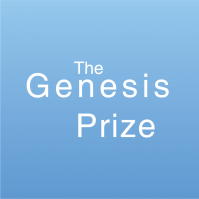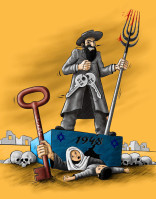Key Issue:Antisemitism and NGOs
Many NGOs that claim to promote human rights and humanitarian agendas use antisemitic themes and imagery to demonize the Jewish people and state of Israel.


A primary area where government commitment to combatting antisemitism has been lacking occurs in the context of NGO funding. As documented by NGO Monitor, these governments, as well as the European Union, have given hundreds of millions of dollars over the past twenty years to organizations that engage in and promote blatant antisemitism as defined by IHRA. The governments and the EU justify such funding by claiming that the recipient organizations are engaged in advancing human rights and humanitarian objectives, or that grants are provided for projects and not for organizations.
Contrary to NGO claims that they are engaging in “legitimate criticism” of Israel, the NGO rhetoric, publications, and activities often violate accepted standards.
Examples:
Amnesty International
Although Amnesty claims that it does not “accept any funds for human rights research from governments or political parties,” it has received governmental funding, including from the UK, the European Commission, the Netherlands, the United States, and Norway.
Amnesty International employs numerous anti-Israel activists and BDS campaigners with well-documented histories of antisemitic rhetoric and radical activism.
Amnesty-UK Campaigns Manager Kristyan Benedict has displayed a strong anti-Israel obsession, fueled by global conspiracy theories involving Israel, the US, and the arms trade, as well as frequent conflations of Israel and individual Jews and Jewish communities. Benedict’s Twitter has also featured antisemitic statements. In November 2014, Benedict posted a tweet comparing Israel to the Islamic State, claiming that “Israeli regimes [sic] response to our Gaza report: Amnesty is ‘a propaganda tool for Hamas & other terror groups’ (#JSIL?).” The Twitter tag “#JSIL” stands for “Jewish State in Levant” and is meant to compare Israel and Judaism with the international terrorist organization ISIL (ISIS), implying that Israel’s activities are tantamount to the mass public executions and beheadings performed by ISIL and that Judaism is equivalent to the extreme form of religion promoted by Islamic State.
At least four Amnesty International employees were members of the virulently antisemitic Facebook group “Palestine Live.” Posts to this group regularly involve heinous antisemitic tropes, imagery, and language – such as conspiratorial posts blaming the Rothschild family for WWI and WWII and Jews for 9/11 and other terror attacks; images featuring Jewish people portrayed as octopuses, monsters, and pigs; and the use of neo-Nazi rhetoric such as the term “Zios.”
Antisemitism is also reflected in Amnesty’s campaigning. For example, in January 2019, Amnesty International published “The Tourism Industry and Israeli Settlements,” a report alleging that “the Israeli government has political and ideological reasons for developing a tourism industry in occupied East Jerusalem and Area C of the West Bank.” In the report, Amnesty denies Jewish connections to Holy Land historical sites – including in the Old City of Jerusalem – and faults Israel for preserving Jewish historical and cultural heritage, as well as places that are holy to Christians.
Human Rights Watch
Donors have included Open Society Institute, Ford Foundation, and the Rockefeller Brothers Foundation.
HRW Executive Director Ken Roth often engages in antagonistic comments towards Jews and Judaism when expressing animus towards Israel. For instance, in August 2014, at the height of the Gaza conflict, Roth promoted a highly propagandistic advertisement published by the Jewish Anti-Zionist Network in The New York Times and The Guardian equating “Nazi genocide” with “the massacre of Palestinians in Gaza.” A picture of the ad was posted with the tagline “‘Never again’ must mean NEVER AGAIN FOR ANYONE!” In September 2014, Roth issued a statement blaming attacks on Jews in Germany and the rise of antisemitism in Europe on Israel’s conduct during the Gaza War.
Sarah Leah Whitson, former Director of the Middle East and North Africa Department, also frequently invokes antisemitic rhetoric and baits the US Jewish community for support of Israel – something she has never done with any other ethnic minority. In January 2015, Whitson commented on a tweet about the US Holocaust Museum’s display of “death and torture in Syria,” stating that the Holocaust Museum should “also show pics of death and destruction in #Gaza” –equating the 2014 war with Hamas to the Holocaust and the extermination of 6 million Jews.
In September 2009, “senior military analyst” Marc Garlasco was revealed to be an obsessive collector of Nazi memorabilia, a “hobby” that is highly controversial and in many European countries, is illegal. In the aftermath of these revelations, rather than condemn Garlasco’s activities and remove his publications from HRW’s website, HRW defended him and tried to justify his actions. Garlasco left HRW in 2010 under secret terms. HRW pledged to conduct an investigation of how he was hired and a review of his reports on Israel, but there is no evidence that this was undertaken. Garlasco’s tainted work remains on HRW’s website with no disclaimer.
BADIL
Donors have included Ireland, Spain, DanChurchAid, Diakonia, Trocaire, and the Human Rights and International Humanitarian Law Secretariat (a joint funding mechanism of Sweden, Switzerland, Denmark, and the Netherlands that closed in 2017).
The Palestinian NGO BADIL promotes a so-called Palestinian “right of return” and leads international BDS
campaigns. As part of its advocacy, BADIL sponsors poster andcaricature contests, where antisemitic and violent imagery is prevalent. In 2010, the 2nd-prize-winning cartoon in BADIL’s caricature competition was a blatant representation of classic antisemitic tropes, including a Jewish man, garbed in traditional Hasidic attire, with a hooked nose and side locks. He stands on top of a box adorned with Jewish stars crushing to death a child, holding keys labeled “US” and “UK” and a pitchfork stylized as a menorah dripping with blood, while skulls litter the ground.
Other antisemitic imagery from BADIL’s competitions:
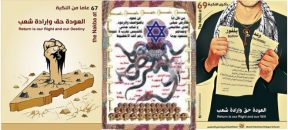 World Council of Churches
World Council of Churches
Donors include: Norway, Bread for the World (Germany), Christian Aid (UK), DanChurchAid (Denmark), Finn Church Aid (Finland), Norwegian Church Aid (Norway), ICCO (Netherlands), Kerk in Actie (Netherlands), UNICEF, as well as numerous other churches and church aid organizations.
The World Council of Churches (WCC) is a collective of “347 churches, denominations and church fellowships in more than 110 countries and territories.”
In January 2019, the World Council of Churches (WCC) was alerted to severe antisemitism taking place under the auspices of its flagship Ecumenical Accompaniment Program, known as EAPPI (see below). Coupled with the expression of concern, WCC was recommended to adopt the IHRA definition to prevent future antisemitic incidents in the EAPPI program. In response, the WCC distorted the IHRA definition and minimized its significance, ignoring its adoption by dozens of countries and multilateral institutions. Specifically, WCC states that it would “welcome a sufficiently precise and sufficiently widely accepted definition of antisemitism to clearly identify instances of condemnable hatred of Jews as Jews, while protecting legitimate criticism of the actions of individuals, groups or of the government of Israel from being falsely characterized as ‘antisemitic’. However, the definition proposed by the International Holocaust Remembrance Alliance (IHRA) does not greatly assist in meeting these purposes. Its vague and inclusive formulation unfortunately tends towards assisting those who would portray any criticism of Israeli government policies as being motivated by antisemitism.”
Ecumenical Accompaniment Programme in Palestine and Israel (EAPPI)
EAPPI, the World Council of Churches’ (WCC) flagship project on Israel and the Arab-Israel conflict, has brought 1,800 volunteers to the West Bank to “witness life under occupation.” The WCC does not run similar activities in other conflict zones. By singling out Israel, EAPPI embodies antisemitism, as defined in the IHRA’s working definition. Despite marketing itself as a human rights and protection program, EAPPI places significant emphasis on political advocacy before, during, and after the trip. When volunteers return to their home countries and churches, they engage in anti-Israel advocacy, such as BDS campaigns and offensively comparing Israel to apartheid South Africa and Nazi Germany.
Participants of EAPPI’s program have made numerous antisemitic, inflammatory and factually inaccurate statements, both during and following their participation in EAPPI. Blogs, presentations, public statements, and social media make these proclamations available to the public. During a September 2017 presentation on EAPPI given by an EAPPI activist, Gordon Timbers of the Presbyterian Church of Canada, an audience member asked, “I don’t know how many people here have seen the model of the gas chambers … and some of these things really remind me [unintelligible] and I often wondered if any Jewish people who go in to see that model ever think of what is set up here” (emphasis added). In his answer, Timbers did not dispute the false claim, answering instead “…Thank you for that, because there are similarities. All these identity papers and restriction of movement and checkpoints and all of these things, yes, that does make people think.”
Kairos Palestine Document
In 2009, a group of thirteen Palestinian Christian clergy, many of whom are anti-Israel activists and pro-BDS campaigners, drafted the Kairos Palestine Document. The purpose was to rally churches globally to support anti-Israel BDS, delegitimization, and demonization campaigns. The Document called for churches to “stand against injustice and apartheid…[and] revisit theologies that justify crimes perpetrated against our people and the dispossession of the land,” and “an economic and commercial boycott of everything produced by the occupation.”
Many organizations have widely denounced the Kairos Palestine Document due to its overt antisemitism. The Central Conference of American Rabbis explains that the Document “echoes supersessionist language of the Christian past, since rejected by most mainstream Christian denominations, referring to the Torah absent Christian revelation as, in the words of the Christian Scriptures, ‘a dead letter.’” The Simon Wiesenthal Center describes it as “a revisionist Document of hatred for Israel and contempt of Jews.”
The Kairos Palestine Document also drew criticism for rationalizing, justifying, and trivializing terrorism, calling it “legal resistance,” and ignoring Palestinian terror, rejectionism, and legitimate Israeli security concerns. Joseph Puder, founder and director of the Interfaith Taskforce for America and Israel, has referred to the Kairos Palestine Document as “essentially a copy of Hamas and Fatah ‘talking points’ wrapped in religious packaging.”
The Document continues to be used by numerous NGOs as a tool to target Israel and bolster BDS campaigns worldwide. (For more on the Document, read NGO Monitor’s Key Issue.)
Miftah
Donors include European Union, Norway, Germany, Ireland, United Nations Population Fund, Oxfam Novib (Netherlands), Arab Fund (Kuwait), Canada Fund, and the Human Rights and International Humanitarian Law Secretariat (a joint funding mechanism of Sweden, Switzerland, Denmark, and the Netherlands that closed in 2017).
In March 2013, Miftah published an article written by Nawaf al-Zaru that repeated the antisemitic blood libel that Jews use Christian blood to bake Passover matzah. He wrote, “Does Obama in fact know the relationship, for example, between ‘Passover’ and ‘Christian blood’… ?! Or ‘Passover’ and ‘Jewish blood rituals…?! Much of the historical stories and tales about Jewish blood rituals in Europe are based on real rituals and are not false as they claim; the Jews used the blood of Christians in the Jewish Passover …” (translated from the original Arabic by NGO Monitor).
After significant public criticism, MIFTAH removed the article, but attacked the blogger who exposed the article for “smearing” the organization and downplayed the centrality of the blood libel in the article.
Oxfam Belgium
Donors include European Union, Belgium, and the United Nations.
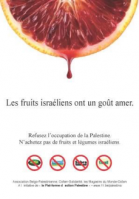
In 2003, Oxfam Belgium produced a poster of an “Israeli orange” dripping with blood to promote anti-Israel boycotts.The caption read: “Israeli fruits have a bitter taste…reject the occupation of Palestine, don’t buy Israeli fruits and vegetables.” Following protest initiated by NGO Monitor over the antisemitic “blood libel” overtones, Oxfam withdrew the campaign.
Women’s Centre for Legal Aid and Counseling (WCLAC)
Donors
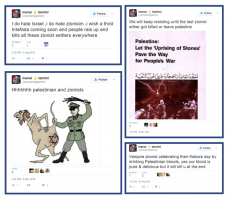
include Norway, European Union, Germany, Canada, Iceland, Oxfam Novib (Netherlands), Dan Church Aid (Denmark), Bread for the World (Germany), Open Society Institute, Broederlijk Delen (Belgium), Caritas Switzerland, and the Human Rights and International Humanitarian Law Secretariat (a joint funding mechanism of Sweden, Switzerland, Denmark, and the Netherlands that closed in 2017).
Despite its lofty claims,WCLAC employs individuals who promote vile antisemitic rhetoric and imagery on social media. For instance, while employed as a WCLAC field worker, Manal Tamimi tweeted, “I do hate Israel, i (sic) wish a thrid Intefada (sic) coming soon and people rais (sic) up and kills all these zionist settlers everywhere.” Despite these grotesque sentiments, WCLAC wrote to the United Nations calling Tamimi a “human rights defender” (in violation of the definition), and the UN “Special Rapporteur on Palestinian territories occupied since 1967”, Michael Lynk, listed her as such in a March 2017 report to the UN Human Rights Council. She was only removed from the report following an official complaint by NGO Monitor, but original versions of the report that promote Tamimi as a “defender” of human right remain on the OHCHR website.
Sponsored by the Speak out for Israel Genesis Grant Prize
